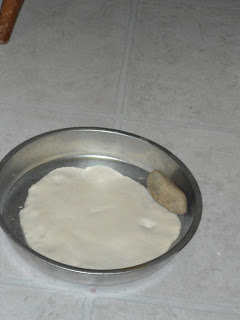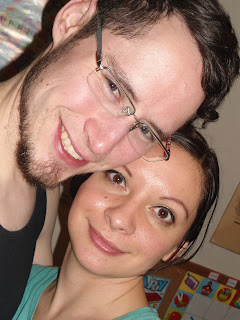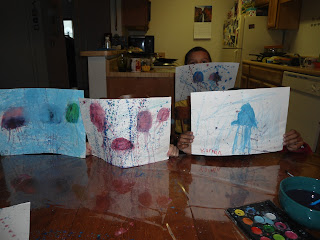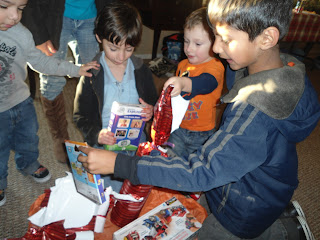We spent what seems like a very short week with Mark Shasha's
Night of the Moonjellies
, a poignant story about seven-year-old Mark who discovers something "that feels like jelly" on the beach as he makes his way to his Grandma Mary's seaside diner, Mar-Gra's. He helps his family run the busy diner, helping to fill ketchup, mustard and relish containers and keeping the straws well-supplied as his grandma, aunt, and cousin serve delicious comfort foods. Later, Mark's grandmother takes him to the place where all the other jellies float about in the sea, and the sight is dazzling and unforgettable.
This story became an instant love after the first reading, and I am sure we will row this treasure again.
Social Studies: Geography- New England
After the first reading, I asked Aidyn if he knew where this story took place. Surprisingly he shouted, "New England!" Many of our FIAR reads have New England settings!
He colored the story disk and happily placed it near New England.
Social Studies: Responsibility
We discussed how responsible Mark is, even though he is only seven years old. I found a wonderful idea from
School Time Snippets to make a Tic-Tac-Toe Responsibility Chart.
He has small chores like "Pick up your toys" and "Wipe the doorknobs" as well as personal grooming responsibilities and school responsibilities. As soon as he makes three in a row (and finishes his school work), he can use his electronics again (which means access to his Nintendo 3DS).
Language: Make a List
I printed an adorable hamburger book from
Homeschool Share, and we listed all the yummy foods mentioned in
Night of the Moonjellies. For vocabulary practice, I wrote the words on a white board as he listed them, and he wrote them in the hamburger book.
Art: Warm and Cool Color Palette
After reading
Night of the Moonjellies on the third day, we looked back at the illustrations and talked about warm and cool colors and perhaps why Shasha might have chosen certain colors for specific objects. For example, the inside of the diner was a warm hue of golden-yellow, but when it was closing time, it was a serene blue. We talked about how warm colors can symbolize warmth, light and activity and how cool colors can symbolize coolness, darkness, and mystery.
Art: Watercolor Jellyfish
This absolutely adorable idea came from
Deep Space Sparkle. It's described as a 4th grade activity, but we were able to handle it well.
His favorite part was when we got really messy and splattered paint everywhere!
So much fun!
Author Background:
After the fourth day of reading, Aidyn asked what the flap at the back of the book was. I explained that it was a snippet about the author, and he said he wanted to know about him. We read that Mark Shasha grew up on the coast of New England to which Aidyn gasped and said, "Just like Mark! (Gasp!) His name is Mark, too. Maybe the story is about him when he was little." We read on and discovered that Mark Shasha had always been fascinated by the sea and sea creatures, which explains the poignancy of his moonjelly portrayal.
Math: Learning about Money
Since
Night of the Moonjellies mainly takes place in a business setting, we skipped a few chapters in our math book to learn about money.
- Through Enchanted Learning, we printed pages about coins, specifically pennies and nickels.
- Aidyn colored a picture of an enlarged penny, and we learned what all the markings on the pennies meant such as the year it was minted and where it was minted (by either the letter D, S, or P under the year). We looked through 100 of our own pennies and found that the vast majority, 99 out of 100, were minted in Denver.
- Coloring Lincoln on the penny led to a zillion questions about the 16th president. Aidyn requested a video about him, which he watched during a break. Later, he and his grandma (a Lincoln expert!) talked at length about the assassination and John Wilkes Booth.
- Aidyn colored a picture of an enlarged nickel, and we also learned all of its markings. Again, most of our 20 nickels were minted in Denver, though we had four from Pennsylvania and one from San Francisco. (Turns out Thomas Jefferson was not as fascinating.)
- We played with money, counting it, comparing coins, and singing "The Money Song."
We must have sang this song a million times!
- Aidyn learned to skip-count by 5s using the nickels.
- He also learned how to count change consisting of a combination of nickels and pennies.
- We played store and I "sold" his erasers to him. I labeled them with different prices (that would need a combination of nickels and pennies to buy), and he bought them all!
Science: Jellyfish
We saved the fun stuff for last. Aidyn loves science and animals, but most non-fiction books about either are dry and boring. Luckily we found
Jellies
by Twig C. George, which is engaging and easy to understand.
Memory Making: Night of the Moonjellies Party
During the week, Aidyn made a menu of items from the book and named his establishment Aidyn's Best Restaurant.
On Friday, he accompanied me to the grocery store where we bought all the necessary ingredients to make hamburgers, hot dogs, fries, banana milkshakes and crab (since they didn't have lobster) rolls.
On Saturday, we invited his friends over for our Moonjelly party. They mostly hung out and played Skylanders and other games, but when it was lunch time, Aidyn handed them the menu and took their orders. I was the cook, and Aidyn played the waiter.
After everyone was full, we painted jellyfish. Aidyn taught the course, and the kids had a blast.
They covered their faces because Aidyn wanted to pretend to be underwater.
We had a BLAST with
Night of the Moonjellies, and I feel like we only skimmed the surface.
Many of my ideas came from
Delightful Learning and the
FIAR forums.
Next up for us is a Tomorrowland: Space and Ocean unit study. Check back to see what we do!












































